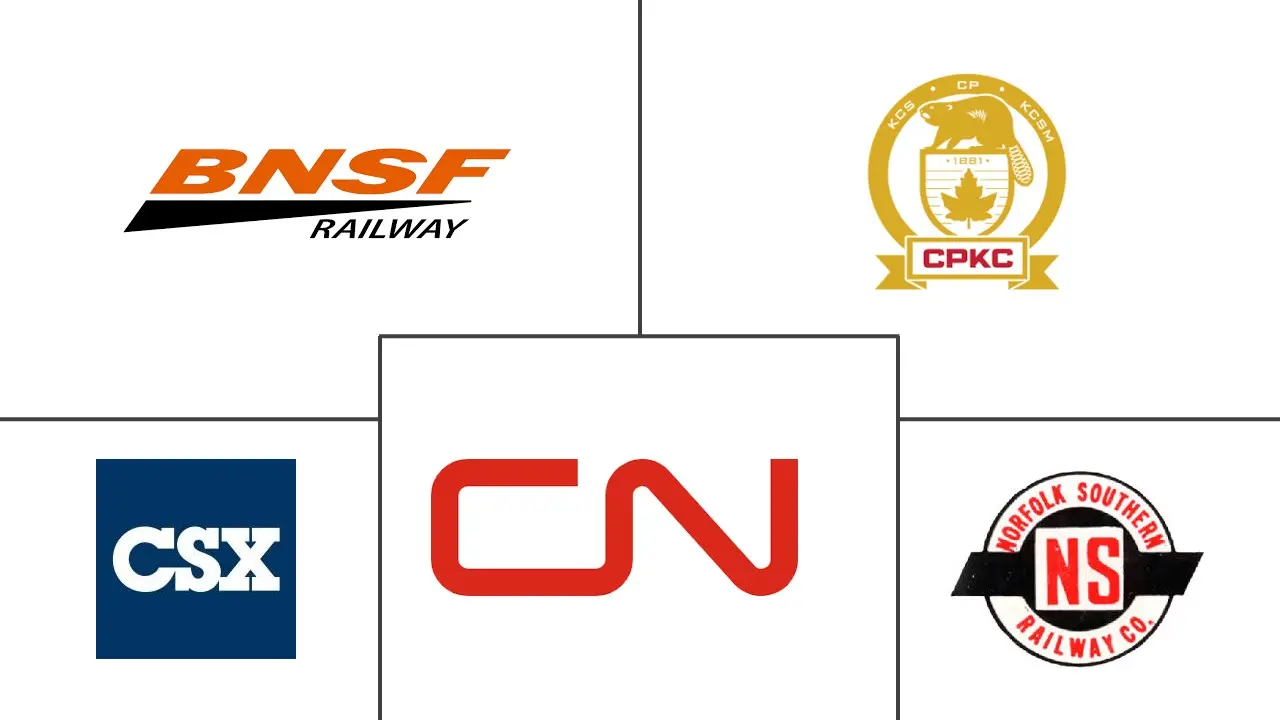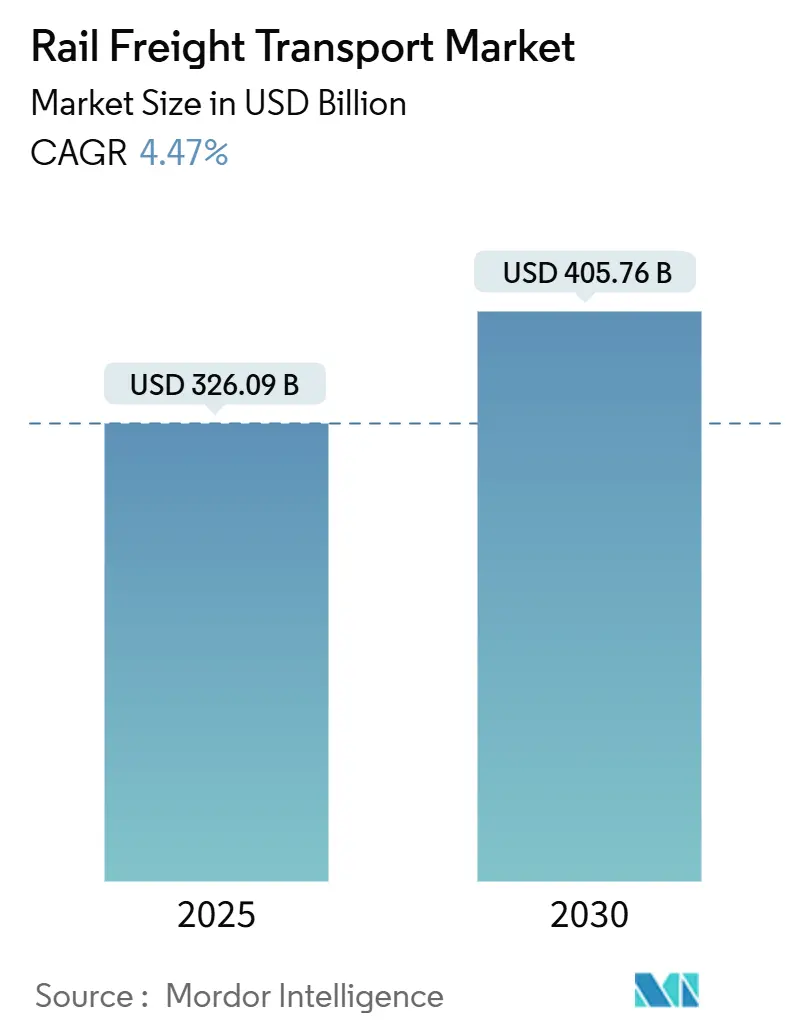
Rail Freight Transport Market Analysis by Mordor Intelligence
The Rail Freight Transport Market size is estimated at USD 326.09 billion in 2025, and is expected to reach USD 405.76 billion by 2030, at a CAGR of 4.47% during the forecast period (2025-2030).
Sustained near-shoring in North America, higher automation along China–EU land bridges, and steady demand for bulk commodities position rail as a cost-efficient, lower-carbon alternative to long-haul trucking and ocean carriage. Asia remains the fastest-growing region thanks to China’s network expansions, while government mandates in the EU and the United States accelerate adoption of electric and hydrogen traction. Intermodal container flows are rising as retailers integrate rail into time-sensitive logistics, and Class I operators continue double-tracking, siding extensions, and inland terminal upgrades that ease capacity constraints. Persistent network congestion in the U.S. Midwest, divergent wagon-coupling standards in Eurasia, and axle-load limits on narrow-gauge African lines temper the market’s full growth potential.
Key Report Takeaways
- By cargo type, dry bulk led with 41% of rail freight transport market share in 2024, whereas containerized/intermodal freight is projected to expand at a 6.2% CAGR through 2030.
- By service type, transportation services held 84% of the rail freight transport market size in 2024; allied services are forecast to register an 7.6% CAGR to 2030.
- By end-user industry, mining & minerals commanded 32% of the rail freight transport market size in 2024, while retail and FMCG is expected to grow at 7.9% CAGR over 2025-2030.
- By traction, diesel accounted for 67% of the rail freight transport market size in 2024; hybrid/hydrogen-ready locomotives will post a 10.2% CAGR.
- By destination, domestic movements captured 61% of 2024 volume; cross-border services will rise at a 6.5% CAGR during the outlook period.
- By region, Asia Pacific is forecast to be the fastest-growing geography with a 6.2% CAGR from 2025 to 2030.
Global Rail Freight Transport Market Trends and Insights
Drivers Impact Analysis
| Driver | (~) % Impact on CAGR Forecast | Geographic Relevance | Impact Timeline |
|---|---|---|---|
| Decarbonization Mandates Driving Modal Shift on Long-haul (more than 800 km) North-South Corridors (EU and NA) | +1.2% | EU and North America, spillover to Asia | Medium term (2-4 years) |
| Near-shoring of Heavy Manufacturing to Mexico and CEE Boosting Cross-border Rail Volumes | +0.9% | North America, Central-Eastern Europe | Short term (≤ 2 years) |
| Energy-transition Commodities (Lithium, Copper) Requiring Bulk Rail Capacity in Andean and Australian Basins | +0.7% | South America, Australia, North America | Medium term (2-4 years) |
| China-EU Land-Bridge Resilience Programs (Post-BRI Optimisation) | +0.6% | Asia, Europe, Middle East | Medium term (2-4 years) |
| Tier-1 Port Congestion in Asia Spurs Inland Rail-based Intermodal to Dry-Ports | +0.5% | Asia with global ripple effects | Short term (≤ 2 years) |
| Government Stimulus for Hydrogen-ready Freight Locomotives in Germany and Japan | +0.4% | Germany, Japan, North America | Long term (≥ 4 years) |
| Source: Mordor Intelligence | |||
Decarbonisation mandates accelerate modal shift on long-haul corridors
Tighter emissions laws in the EU and the United States are nudging long-distance freight off roads and onto rails, a pattern reinforced by the U.S. Rail Energy and Emissions Innovation Action Plan, which charts a path to net-zero greenhouse-gas emissions in rail by 2050[1]U.S. Department of Energy, “An Action Plan for Rail Energy and Emissions Innovation,” energy.gov. Class I operators have started to respond: CSX rolled out its first hydrogen fuel-cell locomotive in April 2024, and CPKC ordered 20 additional fuel-cell engines that will operate on high-density lanes connecting Western Canada and the U.S. Midwest. The regulatory carrot of lower emissions fees pairs with the operational stick of city-center truck restrictions, creating a clear advantage for zero-tailpipe locomotives. With charging and fueling infrastructure now bundled into national clean-transport budgets, the cumulative effect lifts the competitive profile of the rail freight transport market on every lane exceeding 500 miles.
Nearshoring boosts North American cross-border volumes
Manufacturers relocating production from Asia to Mexico are redrawing freight flows between Monterrey, Laredo, and central U.S. hubs. Mexico overtook China as the largest U.S. trade partner in 2024, and rail carriers have responded: CPKC finalized a USD 100 million expansion that doubled capacity on the Laredo-Nuevo Laredo bridge, the busiest rail gateway on the continent[2]Trains Staff, “CSX debuts its first hydrogen-fuel cell locomotive,” trains.com Source: CPKC, “CPKC Doubles Freight Capacity with New U.S.–Mexico Rail Bridge,” supplychain247.com. Schneider National followed by launching a through-train intermodal service linking Mexican origins with the U.S. Southeast, cutting transit times by two days and slashing border dwell times. The resulting surge in auto-parts, electronics, and white-goods traffic positions cross-border services as the fastest-growing slice of the rail freight transport market through 2030.
Energy-transition minerals reshape bulk-rail corridors
The drive to electrify vehicle fleets and expand renewable power is triggering record demand for lithium, nickel, and copper concentrates. Norfolk Southern, already the largest shipper of finished autos in North America, has retooled transload terminals to handle battery-grade materials, aligning with a policy goal for 50% electric-vehicle penetration by 2030. In Tanzania and Burundi, a USD 2.15 billion railway will move 3 million tonnes of nickel ore per year to the port of Dar es Salaam, proving how energy-transition supply chains can justify green-field rail lines. Bulk-rail operators that control origin-to-port routes capture the full upside of this commodity shift.
China-EU land-bridge programs diversify Asia-Europe trade
By late 2024, more than 30% of China–Europe block trains passed through Manzhouli, while the Mohan gateway cleared 10.6 million tonnes of cargo with five-minute customs clearance for priority goods. Automation, e-booking, and smart inspection have cut end-to-end dwell times, though schedule reliability still lags ocean carriers. The signing of the China-Kyrgyzstan-Uzbekistan Railway offers a shorter bypass for southbound containers, potentially lifting throughput on Central-Asian spurs once construction finishes. Together, these projects fortify the rail freight transport market against maritime disruption and widen routing options for high-value cargo.
Restraints Impact Analysis
| Restraint | (~) % Impact on CAGR Forecast | Geographic Relevance | Impact Timeline |
|---|---|---|---|
| Class-I Network Congestion on United States Midwest Grain Routes | −0.8% | United States Midwest | Short term (≤ 2 years) |
| Draft-imposed Axle-Load Limitations on Sub-Saharan Narrow-Gauge Lines | −0.7% | China-Central Asia | Medium term (2-4 years) |
| Divergent Wagon-Coupling Standards Hindering China-Central Asia Through-Traffic | −0.5% | Sub-Saharan Africa | Long term (≥ 4 years) |
| Long-haul Trucking Cost Deflation (2023-24) Narrowing Rail Price Advantage in NAFTA | −0.3% | Global | Short term (≤ 2 years) |
| Source: Mordor Intelligence | |||
Class I congestion constrains United States grain corridors
Grain carloads on U.S. Class I railroads reached 1.07 million in 2024, up 84,000 from the prior year[3]United States Department of Agriculture, “Grain Transportation Report 01-23-25,” ams.usda.gov. Seasonal peaks stretched crew and siding capacity, elongating cycle times for unit trains that feed Gulf Coast export elevators. Chicago, the busiest interchange node, has responded; CN’s siding extension added 17% capacity and boosted area speed by 30%, but recurring backlogs still cause shippers to divert volumes to barge and truck options. The Surface Transportation Board’s proposed reciprocal-switching rule seeks to bring competitive pressure, yet implementation risks prolonging uncertainty in the rail freight transport market’s largest agricultural lane.
Divergent coupling standards slow Eurasian integration
Freight wagons traveling between China and Europe must still negotiate incompatible couplers and multiple track gauges, prompting time-consuming manual breaks in transit. The European Digital Automatic Coupling (DAC) program aims for a continent-wide rollout by 2030, promising automated air, power, and data links that could raise capacity by 30%. China’s pilot gauge-changing wagons, though technically feasible, remain uneconomic for mass deployment, limiting the near-term impact. Until standards converge, extra shunting and handling costs will cap throughput growth on the flagship Belt-and-Road corridors.
Segment Analysis
By Cargo Type: Dominant dry bulk, accelerating intermodal
Dry bulk generated the largest slice of 2024 revenue, accounting for 41% of the rail freight transport market share as high-tonnage coal, ore, and grain sustained baseline volumes across Australia, Brazil, and the U.S. Midwest. The rail freight transport market size for dry bulk is projected to grow modestly in line with commodity demand yet will continue to anchor network utilization levels. Containerized and intermodal traffic, however, is advancing at a 6.9% CAGR, reshaping asset allocation and hub design. Port congestion in Asia and investment in inland dry-ports have elevated rail’s role in the global box cycle.
Dry bulk growth stands on long-term supply agreements with power utilities and steel mills, giving railroads steady cash-flow to modernize motive power fleets. Record e-commerce flows and stricter highway emissions limits trigger Intermodal’s faster expansion. BNSF’s USD 3.8 billion 2025 program, which funds a Phoenix green-field terminal and Chicago capacity upgrades, is a blueprint for doubling-stack corridors with 13.3% year-over-year lifts in international containers. Over the forecast horizon, intermodal’s share of the rail freight transport market is likely to close the gap on bulk, propelling rolling-stock orders for low-emission, high-horsepower locomotives.
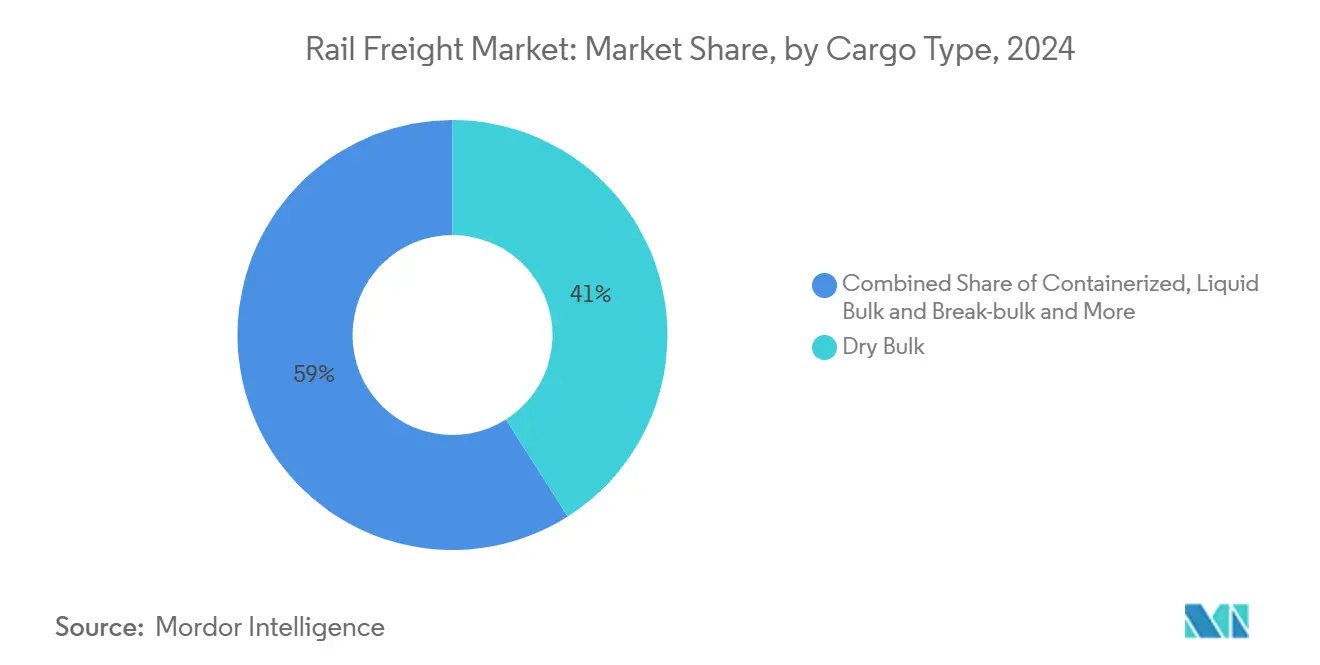
Note: Segment shares of all individual segments available upon report purchase
By Service Type: Transportation commands volume, allied services outpace
Core line-haul transportation controlled 84% of 2024 turnover, reflecting rail’s comparative advantage in energy-efficient, long-haul moves. Tight timetables and economies of scale protect that revenue stream, yet allied services—maintenance, switching, storage, and last-mile drayage—will rise at an 7.6% CAGR as operators widen their profit pools. The rail freight transport market size for allied services is expanding because shippers increasingly outsource wagon upkeep and terminal handling to the same provider that hauls their cargo.
Tailored life-cycle support for hydrogen and battery electric locomotives requires new depots, fueling pads, and digital twins, creating revenue lines previously outside the traditional rail model. France’s decision to carve Fret SNCF into Hexafret and Technis aims to lift service quality and unlock EUR 700 million (approximately USD 797 million) in 2025 revenue, underscoring how specialized maintenance has become a strategic pillar. In North America, several Class I carriers have integrated track-side analytics into subscription packages that guarantee uptime, deepening customer ties and reinforcing stickiness inside the broader rail freight transport market.
By End-User Industry: Mining leads, retail demonstrates speed
Mining and minerals held a 32% revenue share in 2024 thanks to captive origin-destination legs and high mass-to-value ratios. The rail freight transport market size for this segment will edge upward as critical-mineral developments in Australia and South America enter production. Retail and fast-moving consumer goods (FMCG), though smaller today, will clock the fastest 7.9% CAGR through 2030 as omnichannel chains embrace rail-intermodal nodes to satisfy next-day delivery targets.
Mining volumes deliver reciprocity: consistent trainloads support asset cycling and yield management, while the shift to electric-vehicle supply chains widens the mineral mix, lifting average revenue per car. Retail’s sprint benefits from cross-docking innovations and real-time tracking, qualities that attract e-commerce giants looking to decarbonize long-haul legs without sacrificing delivery windows. Norfolk Southern’s marketing of rail-based EV supply-chain solutions illustrates the convergence of mineral extraction, component manufacturing, and finished-vehicle distribution inside the rail freight transport market.
By Traction Type: Diesel holds sway, hydrogen captures growth
Despite steady electrification in Europe and China, diesel locomotives still powered 67% of 2024 global tons, reflecting flexible deployment and limited catenary coverage in North America and parts of Africa. Electric traction delivers zero on-site emissions where wires exist, but the hybrid/hydrogen-ready class is scaling quickest at a 10.2% CAGR, propelled by public funding and tighter fleet emissions caps. The rail freight transport market size for hydrogen locomotives remains small today, yet it represents the most disruptive technology vector.
Field trials by CPKC and CSX have validated hydrogen’s fast refuel cycles and parity in drawbar horsepower relative to diesel. Siemens Mobility’s alliance with Tyczka Hydrogen bundles production, storage, and after-sales service, shrinking adoption friction for operators. In regions where grid capacity is limited or electrification would cost billions, hydrogen becomes the straightest path to 100% renewable traction, and its success could reset locomotive procurement across the rail freight transport market.
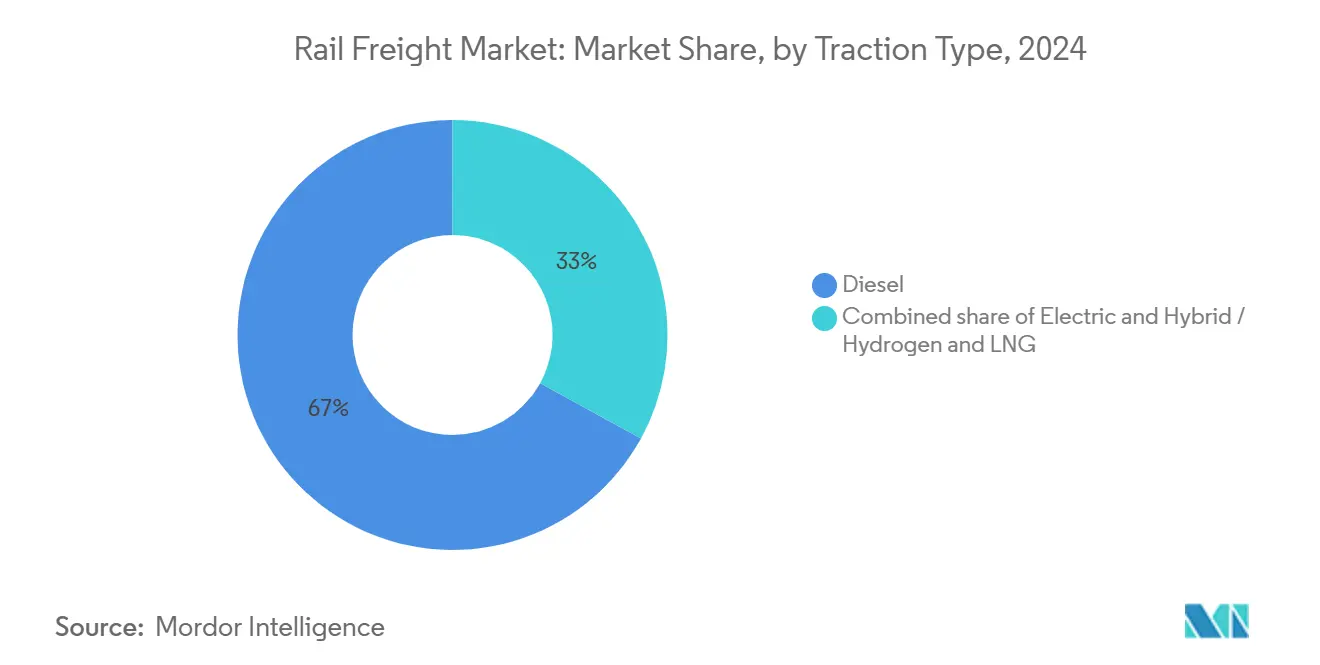
Note: Segment shares of all individual segments available upon report purchase
By Destination: Domestic remains larger, cross-border paces ahead
Domestic traffic captured 61% of 2024 revenue, backed by legacy infrastructure and single-jurisdiction operating rules. International and cross-border volumes, though smaller, will accelerate at 6.5% CAGR through 2030 as customs reform, electronic waybills, and integrated dispatch improve reliability. The rail freight transport market size attached to cross-border lanes already benefits from Trans-European Transport Network corridors and the United States-Mexico-Canada Agreement, which shields rail tariffs and promotes interoperability.
Domestic networks are not static; Class I railroads use precision scheduled railroading to raise train speed and reduce terminal dwell. Yet cross-border lanes promise higher incremental growth. Schneider National’s through-train service from Mexico to Atlanta and Charlotte reduces border stops and slashes CO₂ emissions by 62% compared with all-truck legs. As more shippers weigh resiliency against total landed cost, cross-border trains will define the next phase of innovation in the rail freight transport market.
Geography Analysis
North America’s rail freight transport market benefits from deep Class I capital budgets and near-shoring that channels production to Mexico. The region is forecast to grow at 4.5% CAGR from 2025 to 2030. Union Pacific posted USD 1.8 billion Q4 2024 net income, underpinning track upgrades and locomotive overhauls that support grain, automotive, and energy. CN’s purchase of Iowa Northern Railway adds 175 route-miles to its 20,000-mile matrix, strengthening fertilizer flows. Mexico’s network expansion, including double-tracking at Laredo, secures faster clearance for USD 475 billion in northbound exports and enlarges the rail freight transport market.
Asia Pacific leads global growth with a 6.2% CAGR. By end-2024, 30% of China–Europe unit-trains traversed Manzhouli, aided by five-minute automated customs. India’s dedicated freight corridors near completion, while Japan trials hydrogen locomotives on rural lines. Australia’s Pilbara miners continue investing in heavy-haul railways that move iron ore at 40 tonnes-axle-load to coastal shipping points. Across ASEAN, Vietnam SuperPort’s rail-linked hub in Hanoi exemplifies growing port-rail integration.
Europe’s rail freight transport market is advancing at 4.1% CAGR as liberalization unlocks entry for private operators. Germany channels federal grants into Deutsche Bahn’s H2goesRail program that pairs Siemens family multiple units with on-site hydrogen production deutschebahn.com. France’s Hexafret targets 1,100 long-distance trains per week in 2025, while Spain widens gauge-change facilities on the Mediterranean Corridor. Nordic governments coordinate cross-border electrified links that reinforce the region’s low-carbon freight ambitions.
South America shows 4.1% CAGR potential driven by mineral exports. Chile received a 1 MW hydrogen locomotive for FCAB’s desert routes, designed for high altitude and temperature extremes. Brazil’s concession model attracts private capital to soybean and iron-ore spurs, and Argentina’s rolling-stock upgrades improve crop export lead times. The rail freight transport market size for bulk minerals is poised to rise as critical-metal projects advance.
Middle East and Africa carry the highest forward CAGRs—3.8% and 4.8%, respectively—from smaller bases. The USD 3 billion UAE–Oman rail link will slash Sohar-to-Abu Dhabi transit to 100 minutes, supporting port free-zone integration. South Africa’s Transnet Freight Rail secured USD 1 billion to restore locomotive availability and rebuild export corridors to Richards Bay. Nigeria and Tanzania prioritize standard-gauge networks that connect mineral belts to seaports, expanding the rail freight transport market.
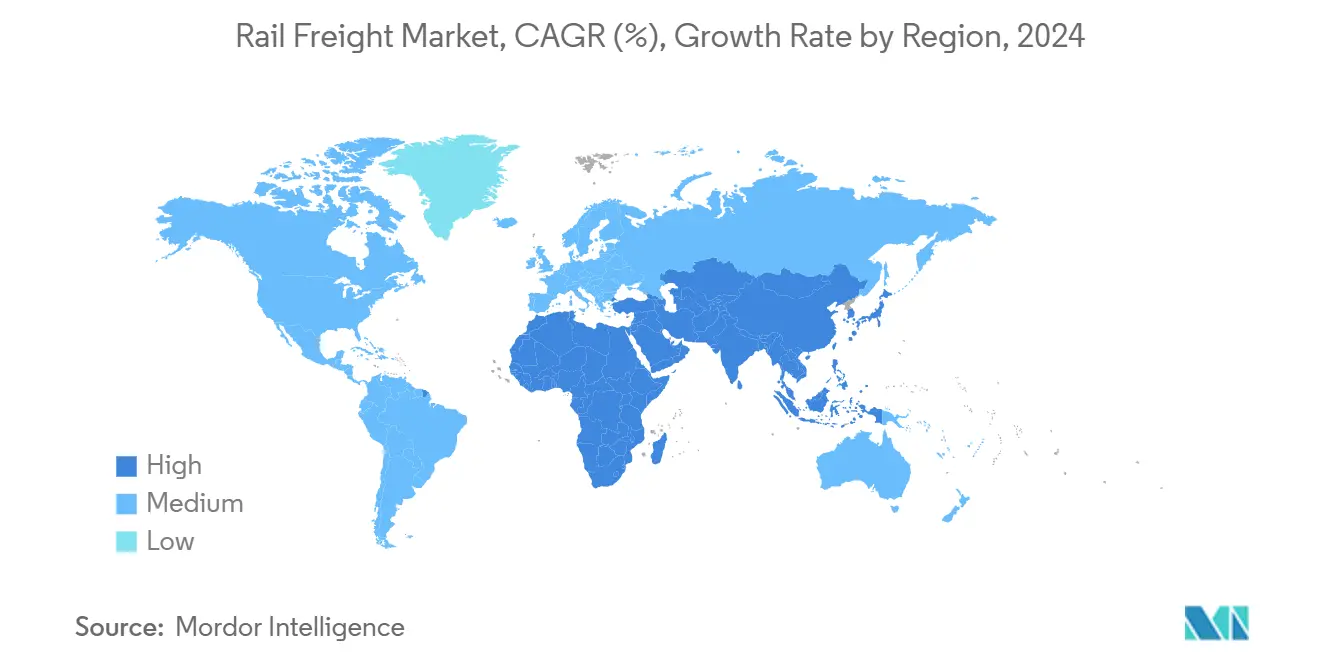
Note: Segments share of all individual segments available upon report purchase
Competitive Landscape
Competition varies by region: North America’s seven Class I carriers still control the bulk of haulage, but intermodal alliances with ocean carriers and truckload firms are redrawing share lines. Union Pacific’s plan to peel bulk freight off trucks relies on precision scheduled railroading, improved service metrics, and customer visibility tools. CPKC leverages its unique single-line Mexico-U.S.-Canada reach to court auto and grain loaders, while BNSF deploys scale to anchor box traffic from Pacific ports. Smaller regionals and short lines carve out niches in first-mile grain gathering and industrial switching, feeding volume to the primary carriers and contributing to a still-fragmented rail freight transport market.
In Europe, market opening has attracted a host of private challengers such as Europorte, which, in partnership with IoT specialist Kerlink, launched wagon-level monitoring that promises predictive maintenance and real-time tracking. National incumbents like DB Cargo and SNCF adapt through fleet modernization and allied-service spin-offs; France’s creation of Hexafret and Technis signals how state operators pivot toward leaner business units. Competition is not limited to carriers—rolling-stock suppliers Wabtec and Siemens vie for orders tied to green traction, as illustrated by Wabtec’s USD 2.58 billion 2024 sales and 20% order growth.
Asia’s competitive story centers on state-owned giants—China State Railway Group and Indian Railways—each investing in high-capacity corridors and digital dispatch. Private-sector slots emerge in containerized service lanes, especially on Belt-and-Road offshoots. Technology integration is the new battleground: AI-assisted scheduling and driver-assist systems promise lower costs per ton-kilometer, rewarding early adopters in the rail freight transport market. Freight car-content rules in the U.S.—effective January 2025—ban sensitive components from designated countries, foreshadowing a localization push that could ripple into multi-regional supply chains.
Rail Freight Transport Industry Leaders
-
BNSF Railway
-
Canadian National Railway
-
Canadian Pacific Kansas City
-
CSX Transportation
-
Norfolk Southern Railway
- *Disclaimer: Major Players sorted in no particular order
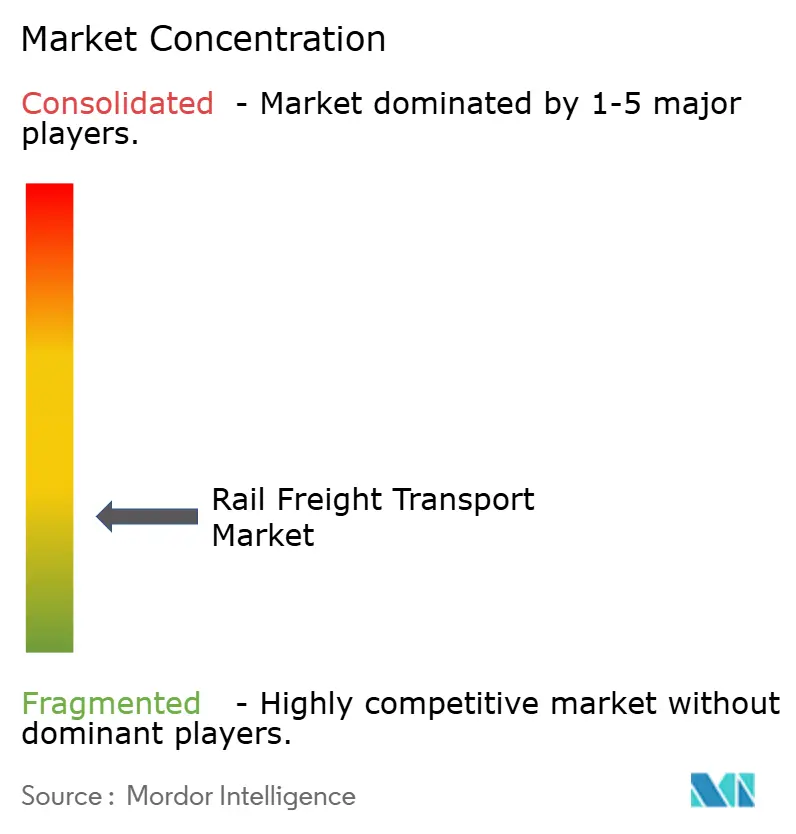
Recent Industry Developments
- February 2025: Ocean Network Express and LX Pantos launched Boxlinks to deliver U.S. domestic intermodal services with Union Pacific, Norfolk Southern, and BNSF as rail partners.
- February 2025: Wabtec reported USD 2.58 billion Q4 2024 sales and recorded a 20% jump in orders, including over USD 1 billion in new locomotives and upgrades.
- January 2025: BNSF announced a USD 3.8 billion 2025 capital program, dedicating USD 2.84 billion to maintenance and USD 535 million to expansion.
- January 2025: The Surface Transportation Board approved CN’s acquisition of Iowa Northern Railway, integrating 175 miles of short-line track with CN’s 20,000-mile system.
Research Methodology Framework and Report Scope
Market Definitions and Key Coverage
Our study views the rail freight transport market as all revenues earned by licensed operators for moving bulk, containerized, or specialized cargo over standard or narrow-gauge track, inclusive of line-haul and last-mile rail services but exclusive of passenger, pipeline, and in-plant industrial shunting. According to Mordor Intelligence, this market was worth USD 326.09 billion in 2025, with forecasts reaching USD 405.76 billion by 2030.
Scope Exclusion: commuter and high-speed passenger services are outside the report.
Segmentation Overview
- By Cargo Type
- Containerised / Intermodal
- Dry Bulk (Coal, Ores, Grains)
- Liquid Bulk (Crude, Chemicals)
- Break-bulk and Project Cargo
- By Service Type
- Transportation
- Services Allied to Transportation (Maintenance of Railcars and Rail Tracks, Switching of Cargo, and Storage)
- By End-user Industry
- Mining and Minerals
- Oil, Gas and Chemicals
- Agriculture and Food
- Manufacturing and Automotive
- Retail and FMCG
- Construction Materials and Forestry
- By Traction Type
- Diesel
- Electric
- Hybrid / Hydrogen and LNG
- By Destination
- Domestic
- International / Cross-border
- By Geography
- North America
- United States
- Canada
- Mexico
- South America
- Brazil
- Peru
- Chile
- Argentina
- Rest of South America
- Asia-Pacific
- India
- China
- Japan
- Australia
- South Korea
- South East Asia (Singapore, Malaysia, Thailand, Indonesia, Vietnam, and Philippines)
- Rest of Asia-Pacific
- Europe
- United Kingdom
- Germany
- France
- Spain
- Italy
- BENELUX (Belgium, Netherlands, and Luxembourg)
- NORDICS (Denmark, Finland, Iceland, Norway, and Sweden)
- Rest of Europe
- Middle East And Africa
- United Arab of Emirates
- Saudi Arabia
- South Africa
- Nigeria
- Rest of Middle East And Africa
- North America
Detailed Research Methodology and Data Validation
Primary Research
Interviews with freight railway executives, intermodal forwarders, rolling-stock lessors, and industry regulators across North America, Europe, Asia Pacific, and key emerging corridors supplied load-factor norms, average service prices, and equipment replacement plans that desktop sources could not offer. These insights let us cross-question every secondary datapoint before locking the model.
Desk Research
We sifted operator traffic statistics from tier-1 bodies such as the International Union of Railways, Eurostat, the US Bureau of Transportation Statistics, and UNCTAD's trade database, then matched them with customs shipment lines from Volza and energy price indices from the World Bank. Company 10-Ks, investor decks, and reputable press helped flag volume shocks or tariff revisions, while D&B Hoovers and Dow Jones Factiva fed us hard-to-reach financial splits. The sources listed illustrate, but do not exhaust, the secondary material that informed this work.
Market-Sizing & Forecasting
One top-down build used national ton-kilometer outputs and average revenue per ton-km to size the 2024 pool, which is then forecast through multivariate regression on drivers such as industrial production, bulk commodity trade, e-commerce led container penetration, diesel-electric fleet additions, regulatory carbon surcharges, and corridor expansion pace. Select bottom-up checks, operator revenue roll-ups and sampled corridor ASP times train pairs, test the totals and close residual gaps. Where carrier disclosures were patchy, we imputed volumes from axle-load data and verified them during follow-up calls.
Data Validation & Update Cycle
Model anomalies trigger variance checks against independent rail capacity and tariff trackers, followed by peer review among Mordor analysts. We refresh figures annually and issue interim updates when policy, strike action, or macro shocks materially move the baseline.
Why Mordor's Rail Freight Baseline Commands Trusted Decision Confidence
Published estimates often diverge because firms pick different service mixes, inflation treatments, and refresh cadences.
Key gap drivers include varying inclusion of terminal handling fees, whether allied logistics services are pooled, currency year choices, and how quickly diesel price swings feed into average tariffs.
Benchmark comparison
| Market Size | Anonymized source | Primary gap driver |
|---|---|---|
| USD 326.09 bn (2025) | Mordor Intelligence | - |
| USD 385.82 bn (2025) | Global Consultancy A | Adds rail logistics warehousing and yards, inflates totals via blended logistics CAGR |
| USD 285.25 bn (2025) | Trade Journal B | Excludes short-haul bulk routes and applies conservative ASP freeze at 2023 levels |
Taken together, the comparison shows that when scope creep or static pricing assumptions are corrected, Mordor's balanced, variable-driven approach yields a defensible baseline that planners can reproduce and stress-test with confidence.
Key Questions Answered in the Report
What is the projected value of the rail freight transport market in 2030?
The rail freight transport market size is forecast to reach USD 405.76 billion by 2030 on the strength of a 4.47% CAGR.
Which cargo segment is growing fastest?
Containerized/intermodal freight is advancing at a 6.2% CAGR, driven by port congestion relief strategies and integrated inland terminals.
How quickly is hydrogen traction expected to scale?
The hybrid/hydrogen-ready traction segment is forecast to grow at an 10.2% CAGR between 2025 and 2030 as operators install refueling networks and regulators tighten emissions caps.
Why is North American cross-border rail volume surging?
Nearshoring to Mexico has elevated rail’s cost advantage, and recent infrastructure upgrades such as the doubled-track Laredo bridge amplify capacity for auto-parts and electronics supply chains.
What technical barrier limits Eurasian rail expansion?
Incompatible wagon-coupling systems and varying track gauges necessitate manual handoffs, adding time and cost until the European Digital Automatic Coupling rollout reaches full scale.
How concentrated is the competitive landscape?
With about 70% of regional traffic in the hands of five major carriers, the market earns a concentration score of 7, indicating high—but not dominant—operator influence on rates and capacity.
Page last updated on:
